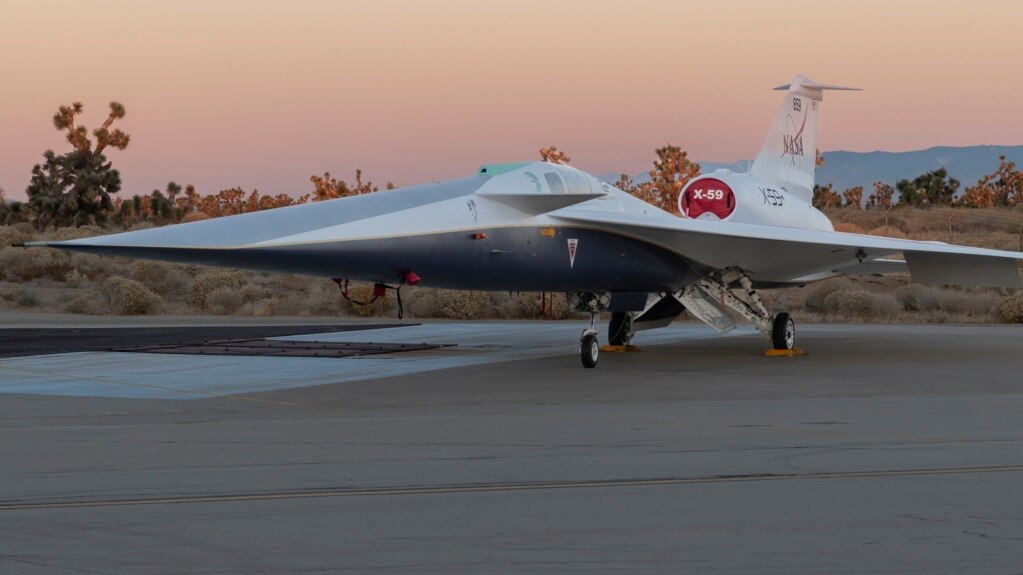The American space agency NASA is preparing to test a new supersonic airplane that could help establish a new generation of superfast aircraft.
The new aircraft is called X-59, and it was built in partnership with American defense contractor Lockheed Martin. The experimental plane is part of a NASA project, or mission, called Quesst.
The mission aims to collect data in the United States on the level of noise produced by supersonic travel. Supersonic describes a vehicle that travels faster than the speed of sound: about 1,235 kilometers an hour.
The data Quesst gathers could lead U.S. officials to change rules that currently ban supersonic flights over land. NASA says the X-59 was developed to reduce the loudness of the sonic boom it produces when breaking the sound barrier to very low levels heard on the ground.
A few U.S. companies are exploring ways to restart supersonic passenger travel for the first time since 2003. That is the year the Concorde aircraft stopped flying. The Concorde was the world’s first supersonic passenger jet. It was operated jointly by Britain and France.
The Concorde flew at speeds more than twice the speed of sound, British Airways explained. This meant it could travel from London to New York in about three-and-a-half hours. The same flight took about eight hours with normal passenger jets.
The new supersonic planes being developed make less noise and use less fuel than the Concorde. But manufacturers are under pressure from environmental groups and airports to meet the same noise and carbon emission limits as traditional planes.
NASA and Lockheed Martin recently showed off the X-59 plane during an event in Palmdale, California.
At the ceremony, NASA Deputy Administrator Pam Melroy called the development of the supersonic aircraft a “major accomplishment.” She noted that members of the NASA and Lockheed Martin teams had worked hard to take the X-59 from an idea to reality “in just a few years.”
Melroy added her hope that the X-59 “will help change the way we travel, bringing us closer together in much less time.”
The aircraft measures 30 meters long and nine meters wide. NASA said in a press release that the X-59 is expected to fly at 1.4 times the speed of sound, or about 1,500 kilometers per hour. The aircraft’s design, shape and technologies will permit it to reach high speeds while producing “a quieter sonic thump,” the agency explained.
The X-59 has not yet completed a test flight. But NASA officials have said they expect that to happen sometime this year. The team will be carrying out other tests in the coming months, including instrument experiments, fast engine runs and ground testing.
Once the aircraft has been cleared to fly, it will be deployed to several cities across the U.S. to collect data on the sounds the plane produces and how people on the ground react to the noise.
The data will be provided to the U.S. Federal Aviation Administration and international flight regulators. The information will help regulators decide whether to change existing laws restricting supersonic flight.
NASA said one of the biggest differences between the X-59 and other supersonic planes is that it has a thinner, smaller nose. The nose, which was reduced by about one-third, aims to break up shock waves that results in more intense sonic booms.
The Quesst team “also designed the aircraft with its engine mounted on top and gave it a smooth underside” in an effort to reduce shock waves near the back of the plane, NASA said.
Another American company developing supersonic aircraft is Boom Supersonic in Colorado. The company first showed off its experimental supersonic plane, the XB-1, in October 2020. Boom has been carrying out tests of the aircraft since then.
The company says on its website that its development and testing activities during the past few years have centered on ground tests, including a series of taxi runs. In 2024, Boom said it plans to begin its “high-speed taxi testing” early in the year, while preparing for an actual flight test that could happen later in the year.
I’m Bryan Lynn.

